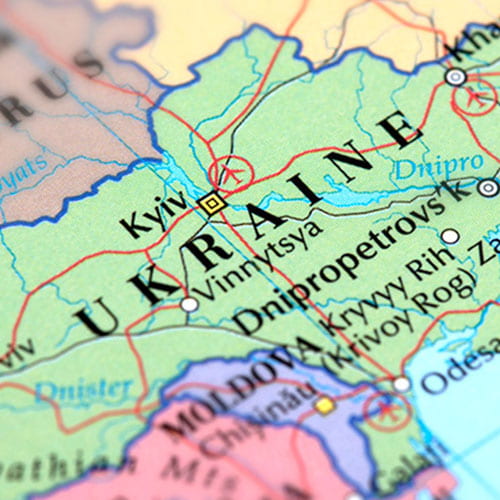By Joe Barnes
Bonner Means Baker Fellow
Things are getting dicey in the ongoing crisis over Ukraine. Russia appears poised to launch an attack of unknown scope or duration. Moscow has assembled a military force of more than 100,000 near Ukraine’s borders.
The origins of the conflict date back centuries and are deeply entangled with Ukraine’s place in Russian history. But the modern history of the crisis originates in the collapse of the Soviet Union in 1991 and the emergence of an independent Ukraine. In geopolitical terms, the period since then has been marked by Russian and the Western jockeying for influence in Ukraine. Russian worries were exacerbated in 2008, when NATO declared that the organization welcomed future membership for Ukraine and Georgia. In 2014, public protests in Ukraine toppled a pro-Russian government in Kyiv. Russia responded by annexing Crimea in a gross violation of international law and providing support to Russian-speaking groups in Eastern Ukraine. Thousands have died in the fighting there. And diplomatic efforts – including the Minsk 1 and Minsk 2 accords – have failed to resolve the dispute.
At one level, Russia’s recent bellicosity is an effort to strengthen its regional sphere of influence and, particularly, to arrest any further drift by Kyiv toward the West. Spheres of influence are a staple of great power politics; the U.S. is no exception, as witness U.S. views toward Latin America for nearly two centuries. (To say this is merely to state a fact; it is not an endorsement of Russia’s behavior or, indeed, U.S. behavior in the Western hemisphere.) The conflict has re-intensified debate about the wisdom of past expansion of NATO and its advisability going forward. While NATO clearly has no intent of admitting Ukraine in the near future, it has also left the door open for eventual membership.
There is also an ideological component to the conflict: Ukraine is, for all its many faults, a much freer country than Russia and the autocratic President Vladimir Putin is surely wary of a thriving, democratic Ukraine at the border. Most Ukrainians, understandably, prefer that their country be oriented to the West both economically and militarily. Russia’s actions in 2014 and subsequently have certainly intensified broad Ukrainian opposition to any effort by Moscow to turn Ukraine into a client state.
President Joe Biden, like Barack Obama, does not consider the territorial integrity of Ukraine to be a vital U.S. national interest. Echoing Obama during the 2014 invasion, Biden has made clear that he will not send U.S. troops to Ukraine. But he is taking the crisis very seriously. Biden has promised to impose severe sanctions should Putin opt to invade. He has sent more arms to Ukraine and talked of deploying more U.S. troops to the region. Major NATO allies are, in general, taking a similar line, though Germany, which remains dependent on Russian natural gas, is more wary of confrontation with Moscow. NATO is an organization of 30 states and by tradition makes decisions by consensus; this makes collective action by the organization difficult.
Talks are ongoing but it is far from clear that they will succeed. Russia has issued a set of demands – including a pledge to cease NATO expansion, not just in the case of Ukraine but for all potential members – that are, as a practical matter, impossible for the U.S. and its allies to accede to. The U.S. has indicated as much in its formal reply, which Moscow has, in turn and predictably, rejected. With such demands, Putin has placed Russia on a course of conflict, with no diplomatic off-ramp in sight. Any occupation of additional Ukrainian territory raises the prospect of an ugly insurgency on Moscow’s hands. The U.S. would likely funnel support to such guerillas, much as we did to anti-Soviet forces in Afghanistan in the 1980s. Perhaps Putin is bluffing. Perhaps some face-saving formula can be reached. We just don’t know. But the risk of war is real. We should disabuse ourselves of the notion that Putin is some strategic genius. He, too, can miscalculate. He, too, can back himself into a corner.
The crisis has implications for the United States that transcend Russia and Ukraine. Thirty years after the end of the Cold War, the United States remains deeply enmeshed in European security. The European members of NATO dwarf Russia in terms of collective GDP and population. But they remain unwilling or unable to handle their own security. Perhaps this is because the Europeans prefer to free-ride on U.S. security guarantees. Perhaps it is because the United States – for all our griping about inadequate European defense expenditures – savors our dominant role in European security arrangements. The current uncomfortable situation is probably the result of a mix of both. The Western Europeans seem incapable of addressing the Russian threat – which, as severe as it is, is a pale shadow of the one represented by the Soviet Union at the height of the Cold War. But with the threat of China rising in the East and our continuing major commitments in the Middle East, the United States may be approaching strategic overstretch. The unipolar moment – those heady years after the collapse of the Soviet Union when the United States bestrode international affairs like a colossus – is gone. And, no matter what the outcome of the current crisis, the United States is overdue for a ruthless assessment of our global commitments.
